After a 1-1 draw at the end of extra time, Croatia knocked Brazil out of the 2022 FIFA World Cup on penalties, meaning that the favourites exited the tournament at the quarter-final stage. Brazil seemed near-invincible in some of their performances at the tournament, especially at the beginning of the group stage.
However, the first kinks in their armour appeared in their final group-stage game when they suffered a 1-0 loss to Cameroon. Now, they’ve been sent home from Qatar by Zlatko Dalić’s side who are set to take on Brazil’s old enemies Argentina in the semi-finals.
This tactical analysis piece will provide a tactical analysis of Brazil 1-1 Croatia, looking at both teams’ tactics and approach to the game in and out of possession, and how they held each other to a stalemate in 90 minutes before again ending up equal at the end of extra time.
Lineups
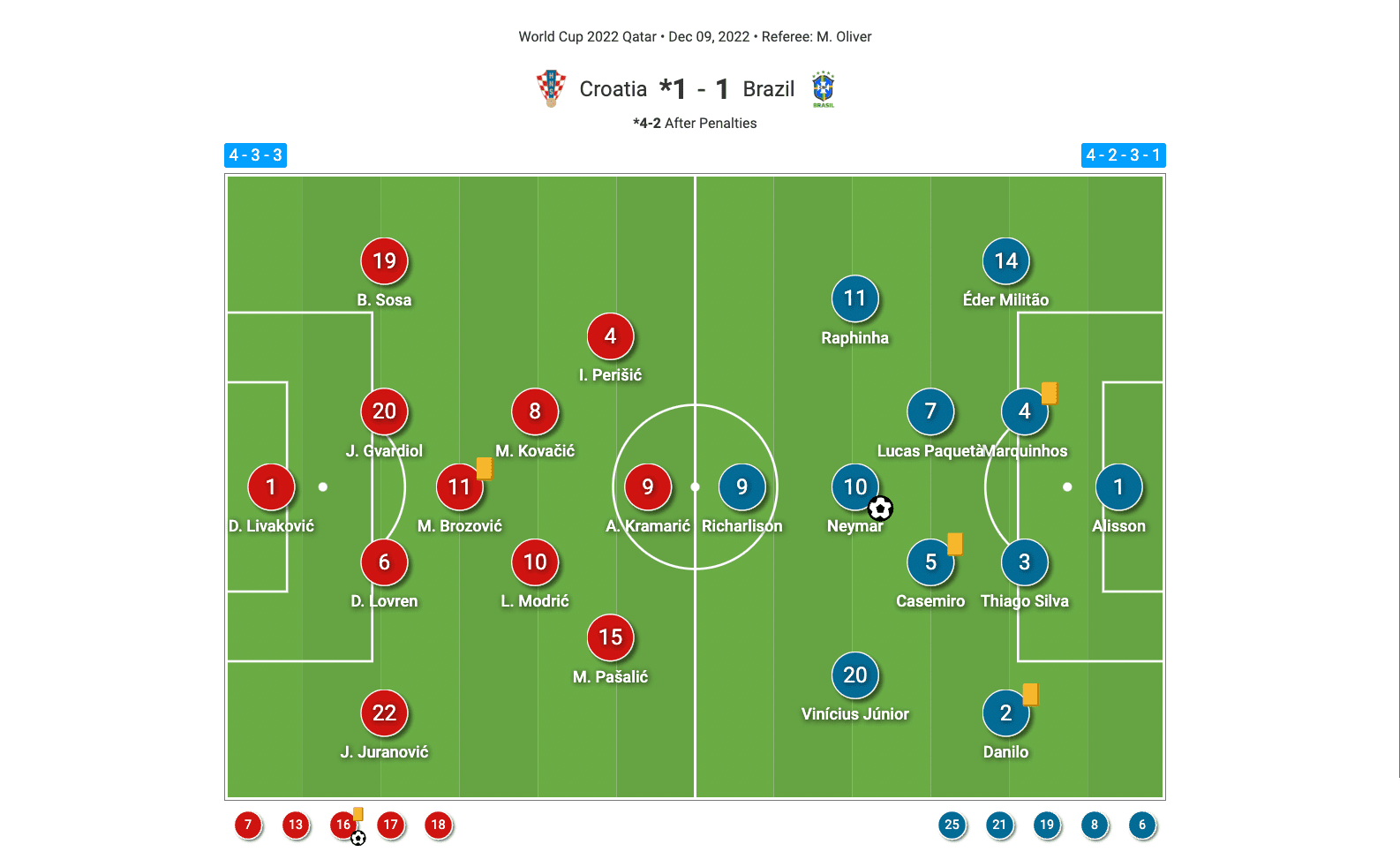
Dalić lined his team up in a 4-3-3 shape with Dominik Livaković in goal behind a back four consisting of right-back Josip Juranović, right centre-back Dejan Lovren, left centre-back Joško Gvardiol and left-back Borna Sosa.
Inter’s Marcelo Brozović started at the base of Croatia’s midfield with Real Madrid legend Luka Modrić to his right and Chelsea’s Mateo Kovačić to his left. Ivan Perišić lined up at left wing for Dalić’s team with Mario Pašalić on the right and Andrej Kramarić completing the starting XI up front.
Dalić made five changes to his lineup throughout the game. Firstly, a 72nd-minute double substitution saw Bruno Petković replace Kramarić up front and Nikola Vlašić take over from Pašalić. Lovro Majer came on in the 105th minute to replace Kovačić in midfield before Ante Budimir came on to replace Sosa in the 110th minute as Croatia trailed by one and finally, Mislav Oršić replaced Brozović just before Croatia equalised through the first sub, Petković, in the 117th minute.
As for Brazil, Tite lined his side up in a 4-2-3-1 shape with Alisson Becker in goal behind a back four of right-back Éder Militão, right centre-back Marquinhos, left centre-back Thiago Silva and left-back Danilo.
Casemiro and Lucas Paquetá occupied the deep midfield positions behind Vinícius Junior on the left, Raphinha on the right and Neymar as a ‘10’. Richarlison led the line for Brazil up top.
Tite also introduced five substitutes over the course of the game. The first came in the 56th minute as Manchester United‘s Antony replaced Barcelona‘s Raphinha. Then, in the 64th minute, Real Madrid players swapped for Brazil as Rodrygo took over from Vinícius Junior. Just before the end of normal time, Flamengo’s Pedro replaced Richarlison up top.
A Seleção’s final substitutions came in the 105th minute, as Fred replaced Paquetá and Alex Sandro came on for Militão.
Brazil’s attempts to play through Croatia’s defensive shape
The first section of our analysis focuses on Brazil’s in-possession game, particularly in the early possession phases. Brazil kept a little bit less of the ball (48.43%) than Croatia (51.57%) in this game and played just slightly fewer passes (659 — 88.62% accuracy) than their opponents (679 — 88.37% accuracy). They played fewer forward passes than Croatia (203 Brasil, 234 Croatia) as well.
Brazil were typically a little more careful with the ball, they didn’t go long as often and tried to be a bit more patient with their play to ensure they generated good, clear openings to cut through the opposition’s defensive shape without rushing into things and giving the opponent an easy chance to intercept and counterattack.
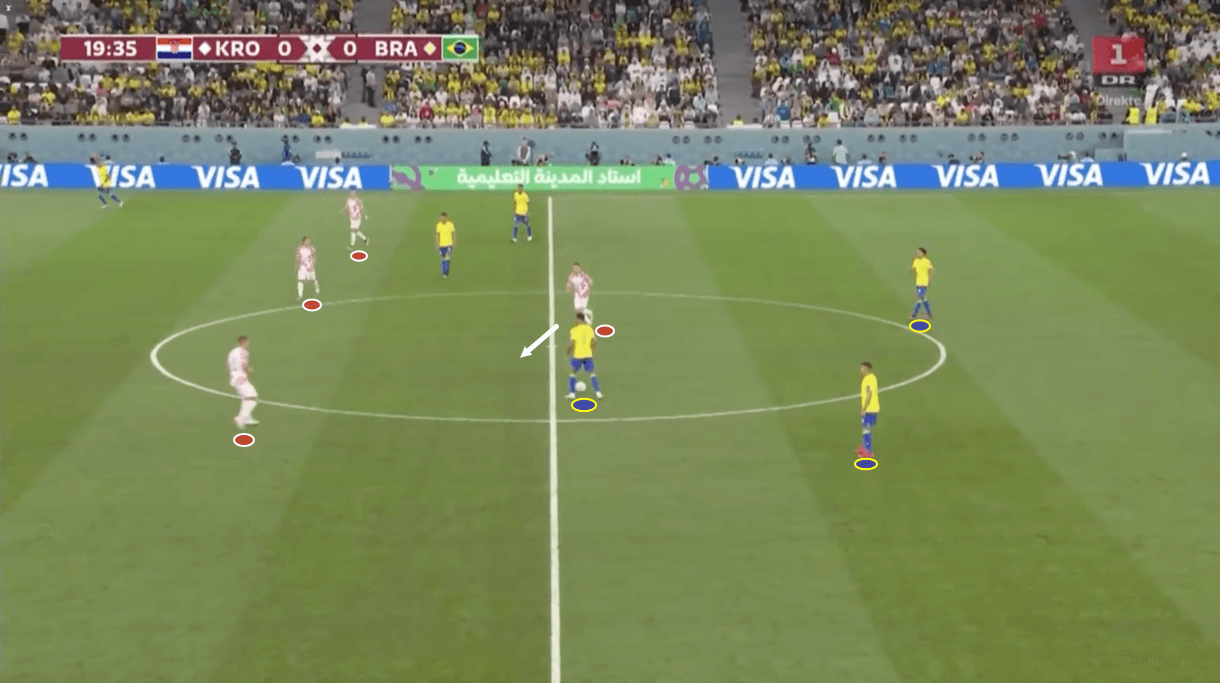
Figure 2 shows Brazil’s typical build-up shape from this game, they liked to form a 2-2 box shape at the base of their in-possession shape between the centre-backs and Paquetá. However, we’d often see Paquetá sitting higher as well, which would drag a Croatia midfielder into deeper territory as Croatia’s midfield trio defended in a very man-oriented fashion against Brazil’s midfield three, especially Paquetá and Neymar who had lots of license to roam around.
They would defend aggressively against Casemiro too but depending on how deep the Manchester United midfielder dropped to get on the ball, he might be passed off to the striker instead, as was the case in figure 2. Croatia wanted to keep a compact, organised shape with little space for the likes of Neymar, Vinícius Junior, Raphinha and Paquetá to exploit between the lines, where their dribbling and creativity would be at their most dangerous. As a result, they couldn’t follow the Brazilian midfielders man-for-man everywhere, it’s too risky a tactic that would leave massive gaps for the Brazilians to exploit.
Within reason, the Croatian midfielders stuck very tight to their men, however.
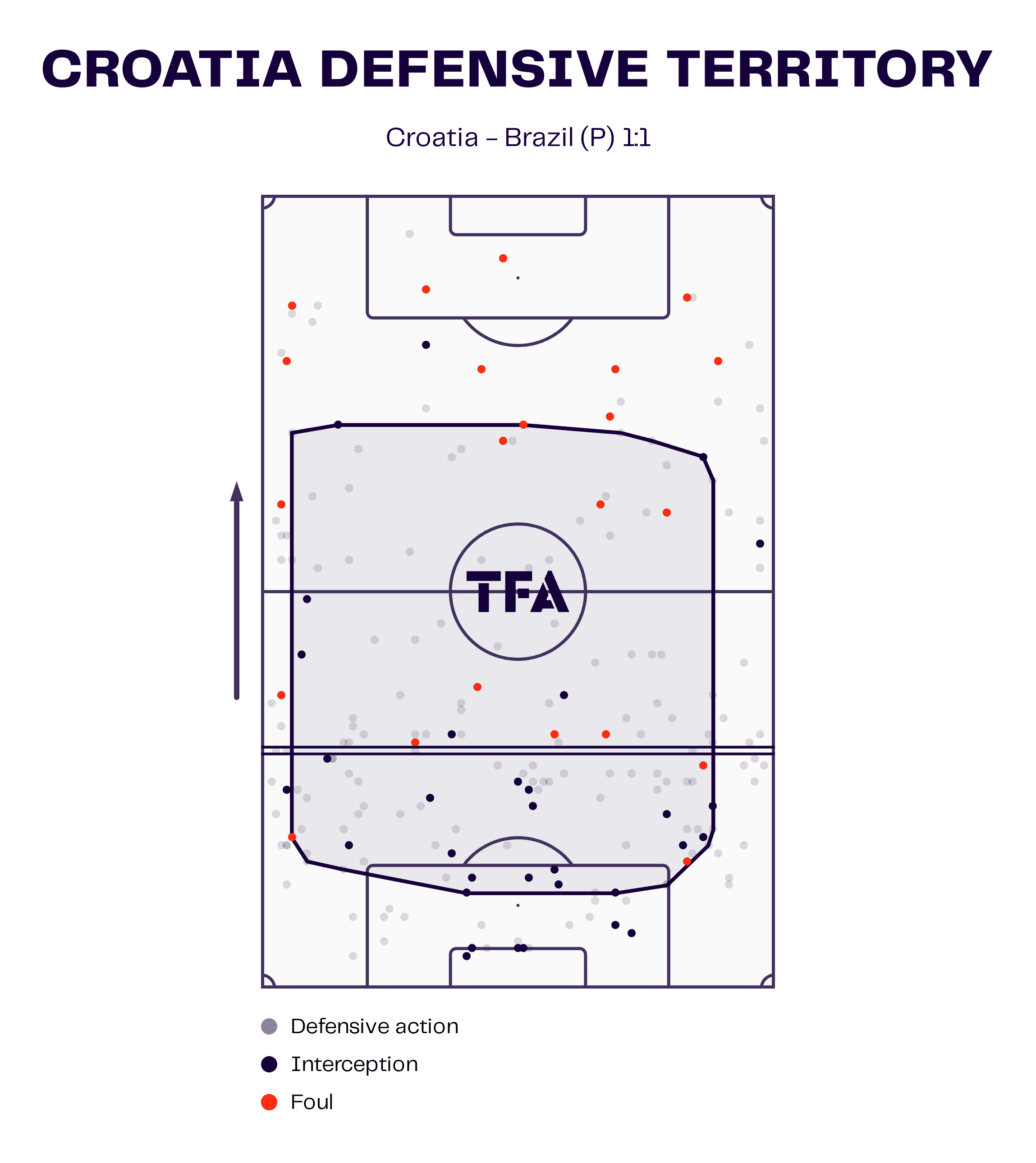
Figure 3 shows Croatia’s defensive territory from Friday’s game, and we can see from this figure how Dalić’s side generally held a lower defensive line, for the most part allowing Brazil to progress into their half before applying major pressure.
Again, Croatia’s focus here was denying Brazilian players time and space in key areas for chance creation like zone 14, or the zones on either side of it, and figure 3 shows they did a good job of intercepting and engaging the Brazil attackers in these key areas without committing many fouls in dangerous positions.
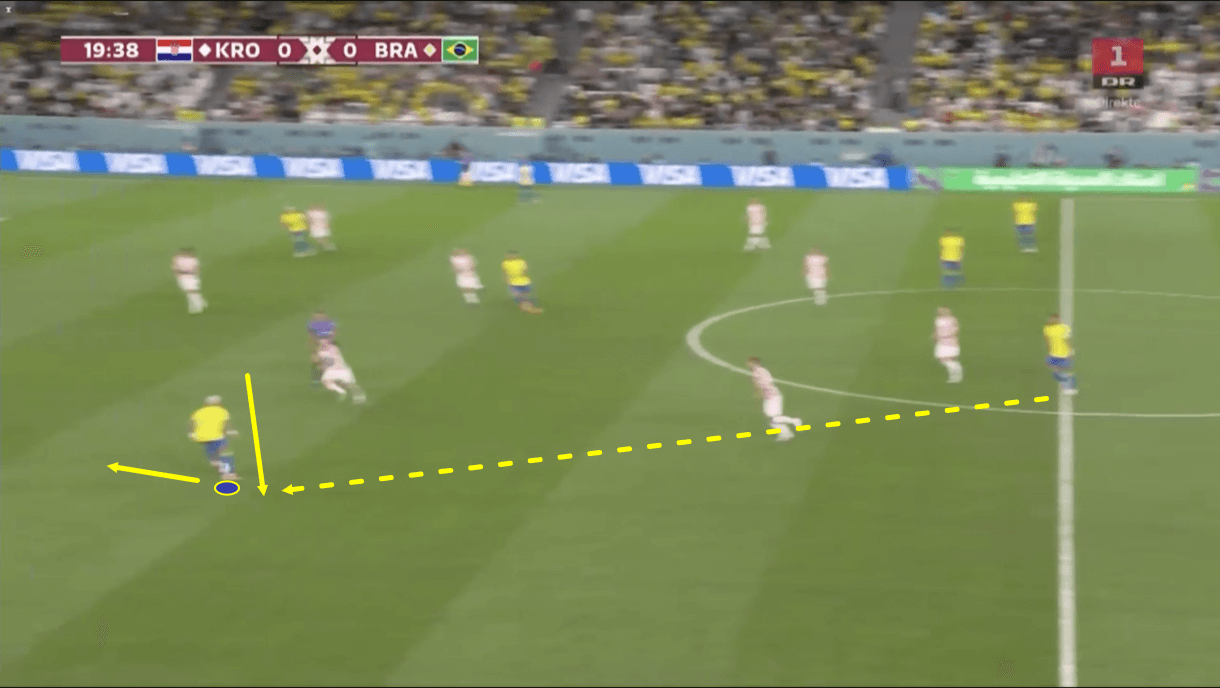
Movement from ‘10’ Neymar was the key thing to look out for as Brasil aimed to progress into the final third. The PSG attacker was constantly moving about to find and occupy space in dangerous positions to give his deeper teammates a good passing option, which we see an example of in figure 4. Neymar offered a significant threat via his off-the-ball movement and created plenty of problems for Croatia by dropping deeper or wider to get on the ball, turn and run at an exposed Croatian defence.
Brazil’s efforts in the final third
Our next section of analysis focuses on what Brazil tended to do once they reached the final third. They demonstrated some recurring ideas throughout the game in order to try and crack the Croatian shell. The first thing we’ll focus on in this section is the intricate link-up play Brazil’s impressive attackers displayed.
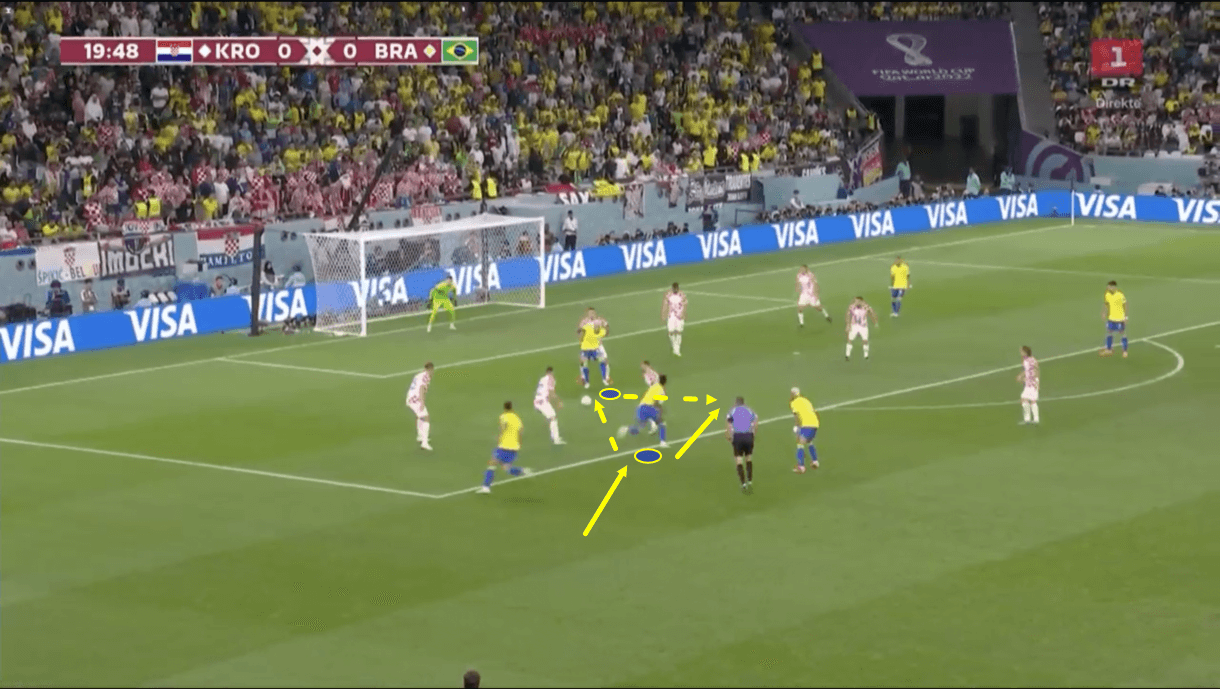
We often saw Neymar or the wingers carrying the ball centrally and linking up with each other or with Richarlison whose job it sometimes was to bounce the ball off him into his teammates’ path to set up a shooting opportunity. We see an example of this in figures 5-6. Firstly, we see Vinícius after just carrying the ball inside, spotting some space behind the defender who’s come out to engage him, and aiming to occupy that space after playing the ball to hold up man Richarlison with his back to goal here.
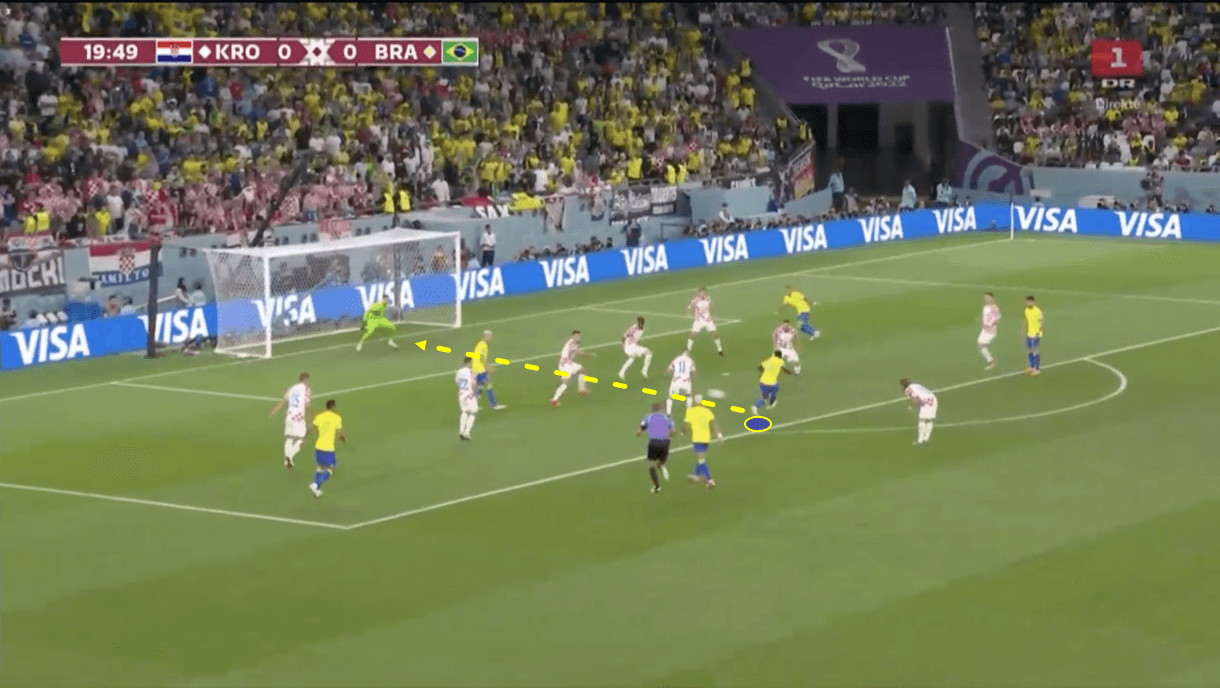
Richarlison does his job well, puts the ball into a good shooting position for the Real Madrid man and sets up the goalscoring opportunity, which ultimately doesn’t come off on this occasion. This kind of attack was one way in which Brazil attempted to break down Croatia throughout Friday’s contest.
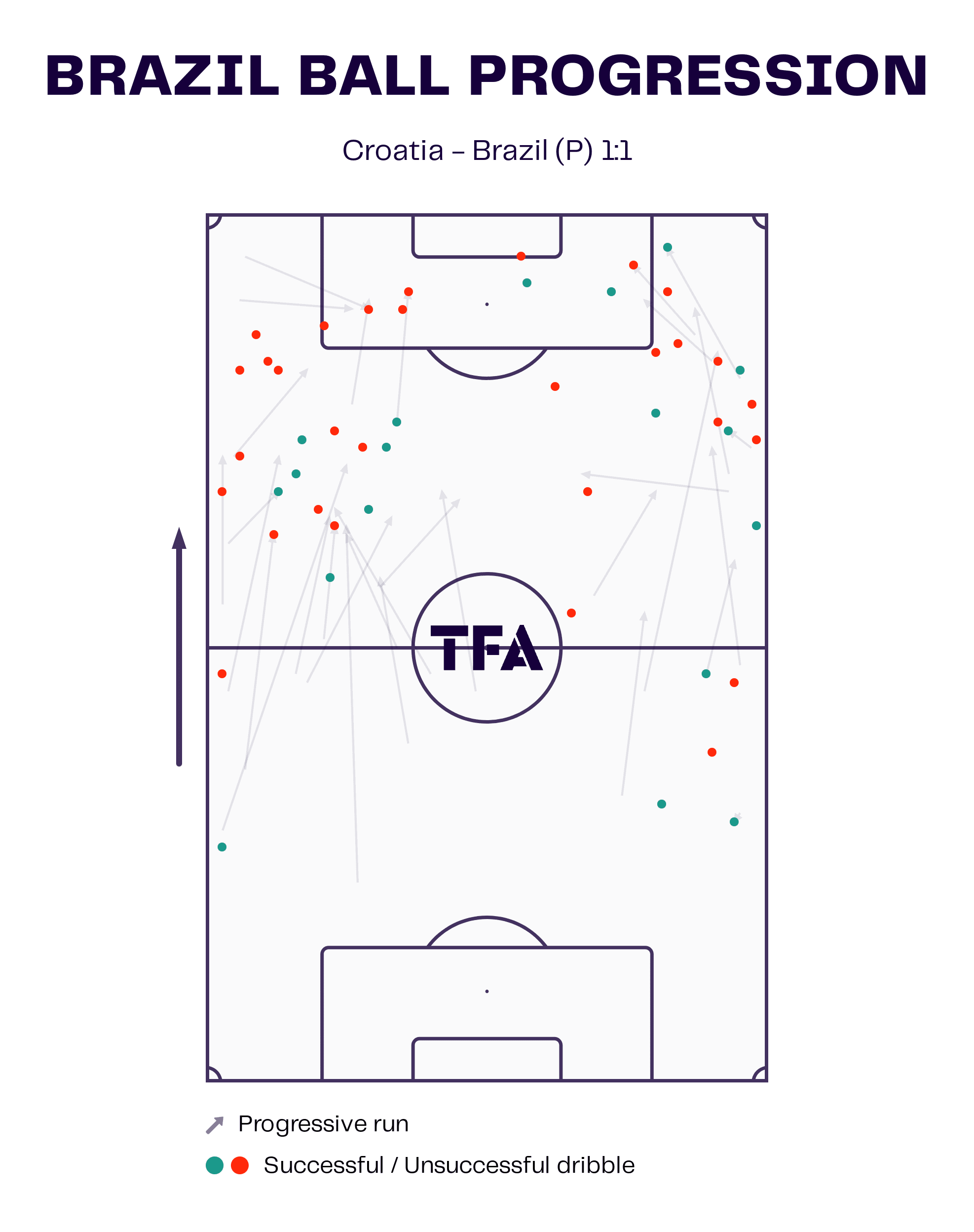
Brazil used the wings a lot once they entered the final third. Indeed, they had great players in these positions but they were also forced to use these areas so much due to Croatia’s solid defending in central areas, as discussed in the previous section.
Brazil generated a lot of 1v1s on the wings and as figure 7 shows, their success rate wasn’t immaculate, especially in advanced areas. Brazil’s dribbles closer to the box were often unsuccessful as Croatia could remain more compact and the defender engaging in the 1v1 was supported from behind by another teammate better than when the defender was dragged away from the box a bit more, giving the Brazilian attacker more of an opportunity to get past.
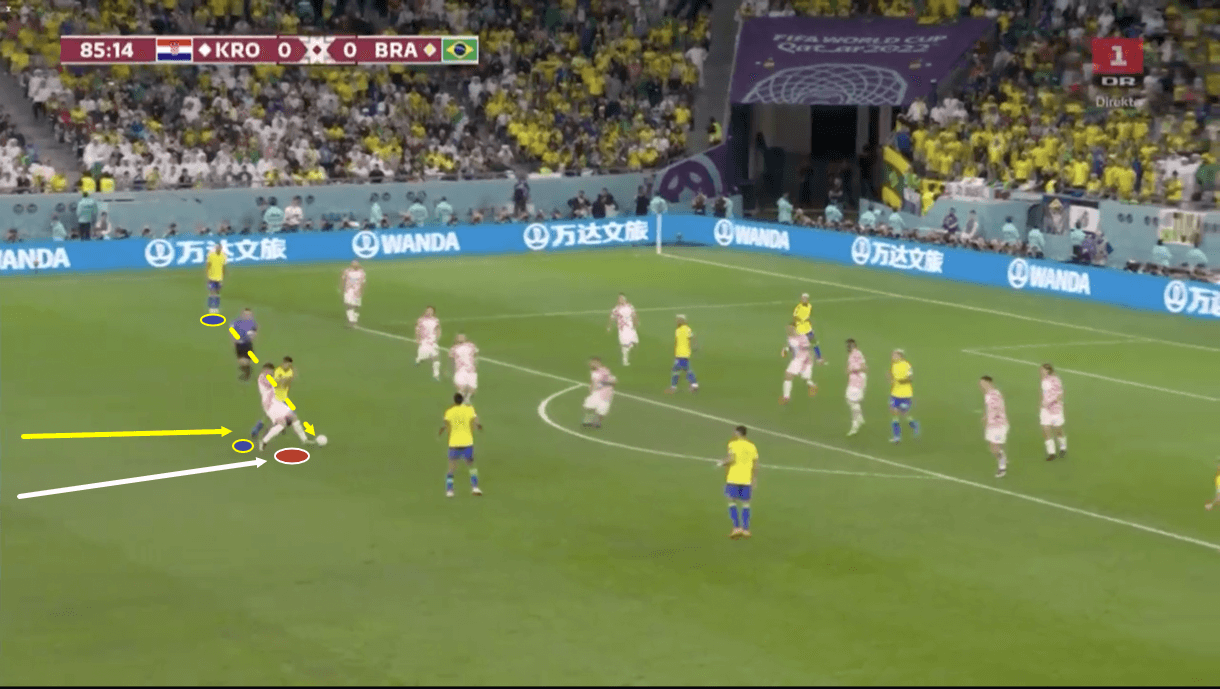
The attitude of the Croatian defence was fantastic for the whole game. All players had to defend with a lot of commitment and energy — as a team — and they achieved this goal, which is a big part of why they made it through to the semi-finals. Forwards had to track back and help out to prevent the deeper players from being dragged out of position and space then opening up for Brazil’s attackers to exploit. We see an example of this in figure 8, where the forward has tracked back and made a vital interception on the edge of his own box.
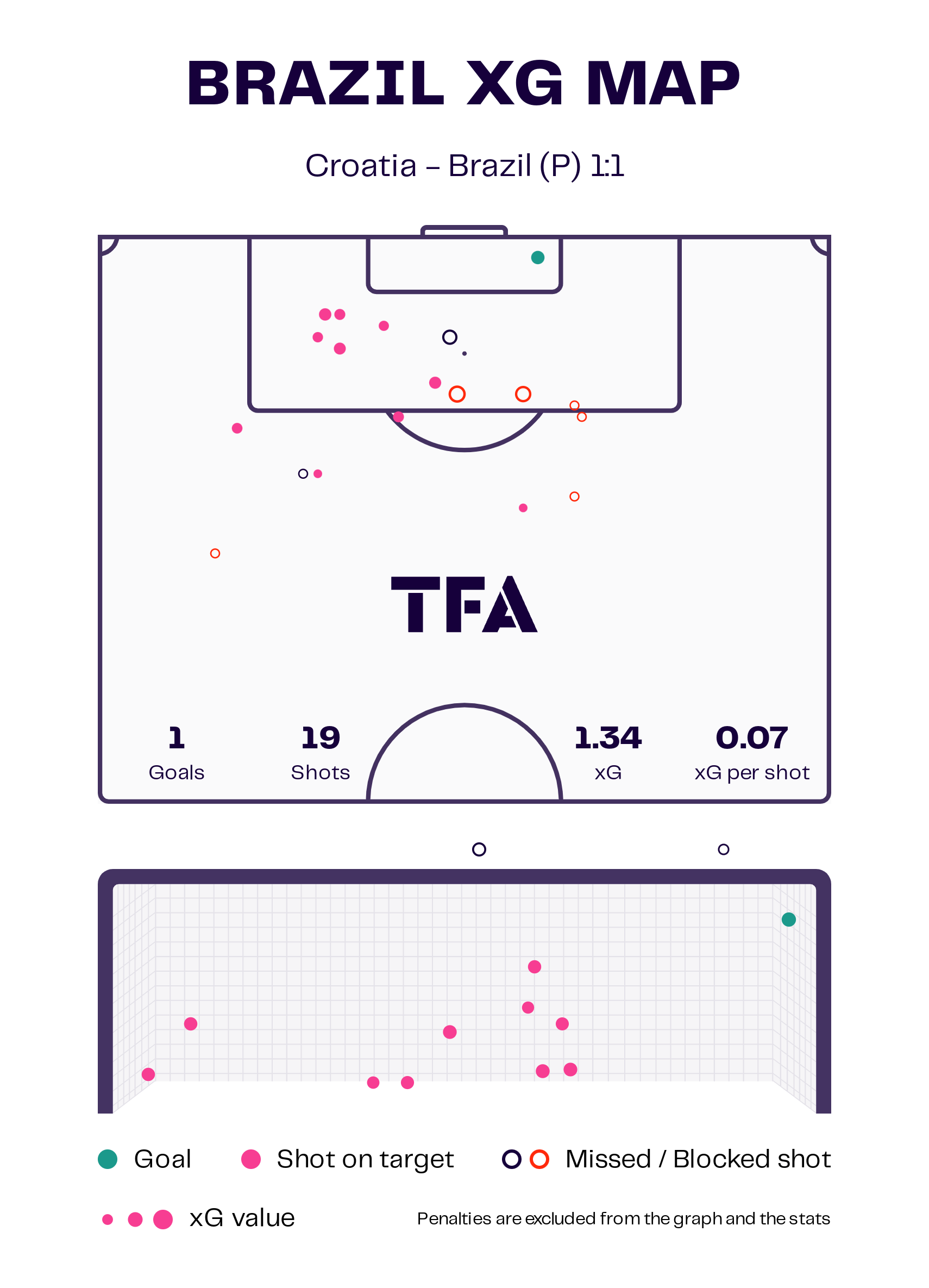
Dalić got a lot of commitment and energy like this from his team in Friday’s game and they ultimately did well to limit Brazil to low-value chances, as we see in figure 9, due to being so difficult to break down and getting bodies back behind the ball.
Croatia’s build-up play
Next up, we’ll take a look at Croatia’s build-up play. Dalić’s side generally built up with a 2-1 base shape, with Brozović normally playing in the deepest midfield position behind Modrić and Kovačić. We see an example of this shape in action below in figure 10.
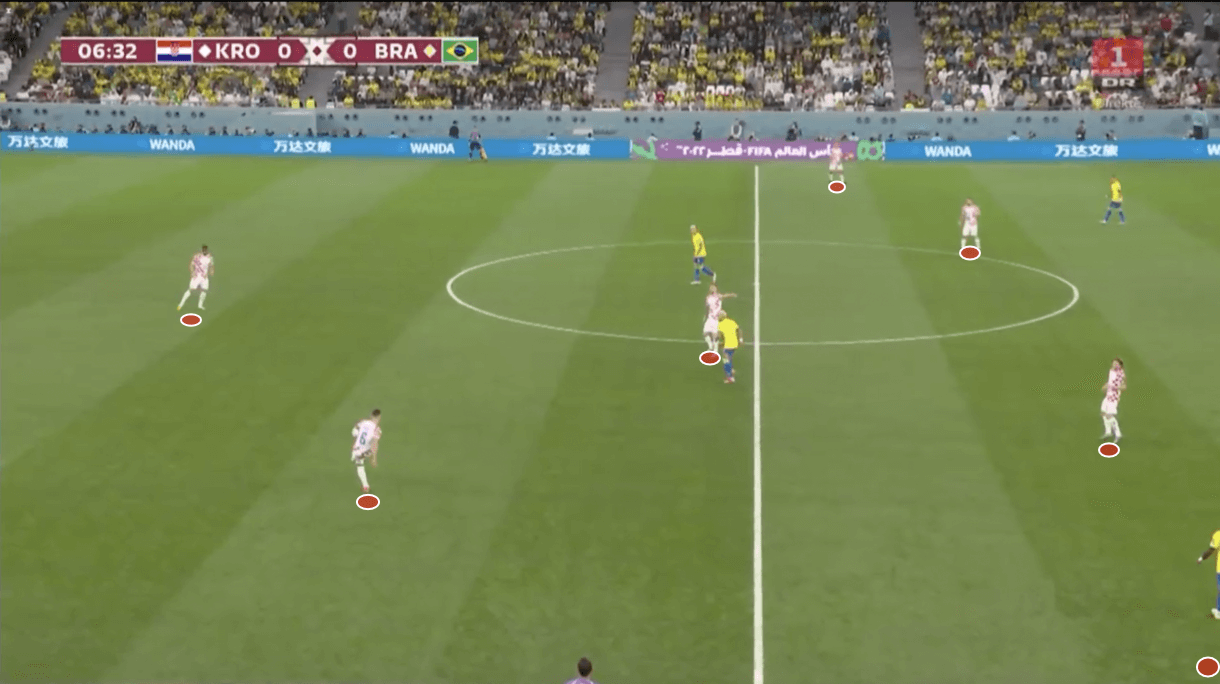
As the game wore on, it became more and more common to see Modrić dropping deep to get on the ball and assist with the build-up as well, with the 2018 Ballon d’Or winner sometimes being spotted between the centre-backs where he could play with less pressure from the Brazil defenders and look to spray the ball around the pitch.
As mentioned earlier, Dalić was far happier for his side to play the ball long to progress upfield than Tite was. This resulted in Croatia playing 65 long passes (70.77% accuracy) to Brazil’s 27 (37.04% accuracy). It was evident that long passing to get upfield and into the final third was a key part of Croatia’s gameplan heading into this one, and these tactics exploited the ball-playing strengths of the Croatian centre-backs as well as Modrić when he dropped so deep, so the idea made plenty of sense.
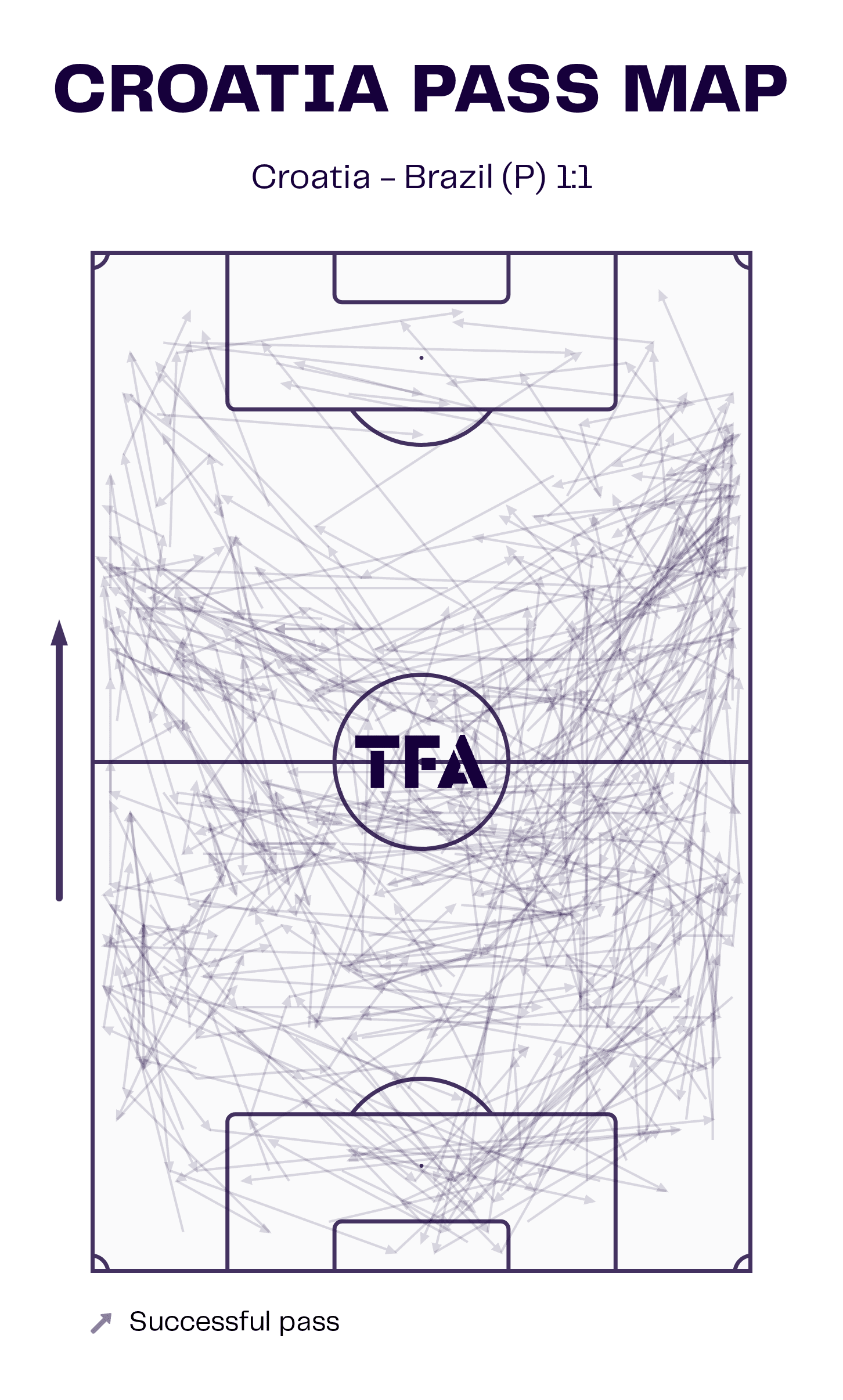
The pass map in figure 11 shows how Croatia typically entered the final third via the wings, very rarely touching the ball centrally inside Brazil’s half of the pitch. Although they usually used a much higher defensive line, Brazil, like Croatia, defended the central areas quite well, getting compact and denying Croatia many opportunities to progress in advanced areas through the centre. Again, this is a big part of why Modrić felt the need to drop so deep in order to get involved in the game.
They sent a lot of long passes out to the wings where they tried to generate wide overloads and create goalscoring opportunities.
Croatia’s wide overloads
Croatia generated fewer shooting opportunities and a lower xG than Brazil in this game. They didn’t come into this game with the same offensive might as Brazil, so it’s no surprise they generated fewer chances. We see Croatia’s xG map in figure 12, to compare with Brazil’s xG map from figure 9. Neither side ran away with it in terms of chance creation in this one.
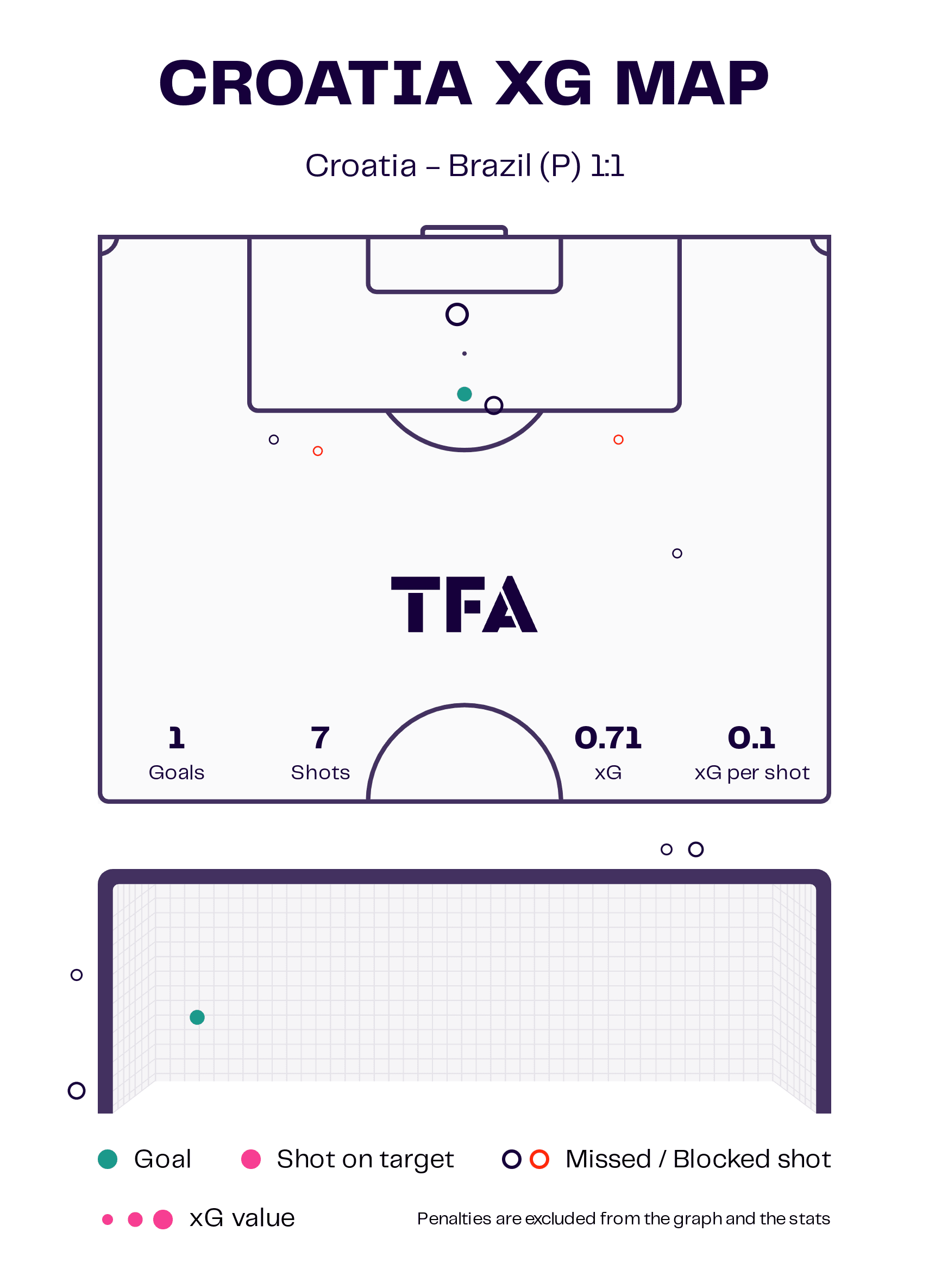
The chances that Croatia did create generally came via their wing play. There were several occasions during this game when Croatia overloaded Brazil out wide and created something for themselves as a result, including their 117th-minute goal, which came from such a situation.
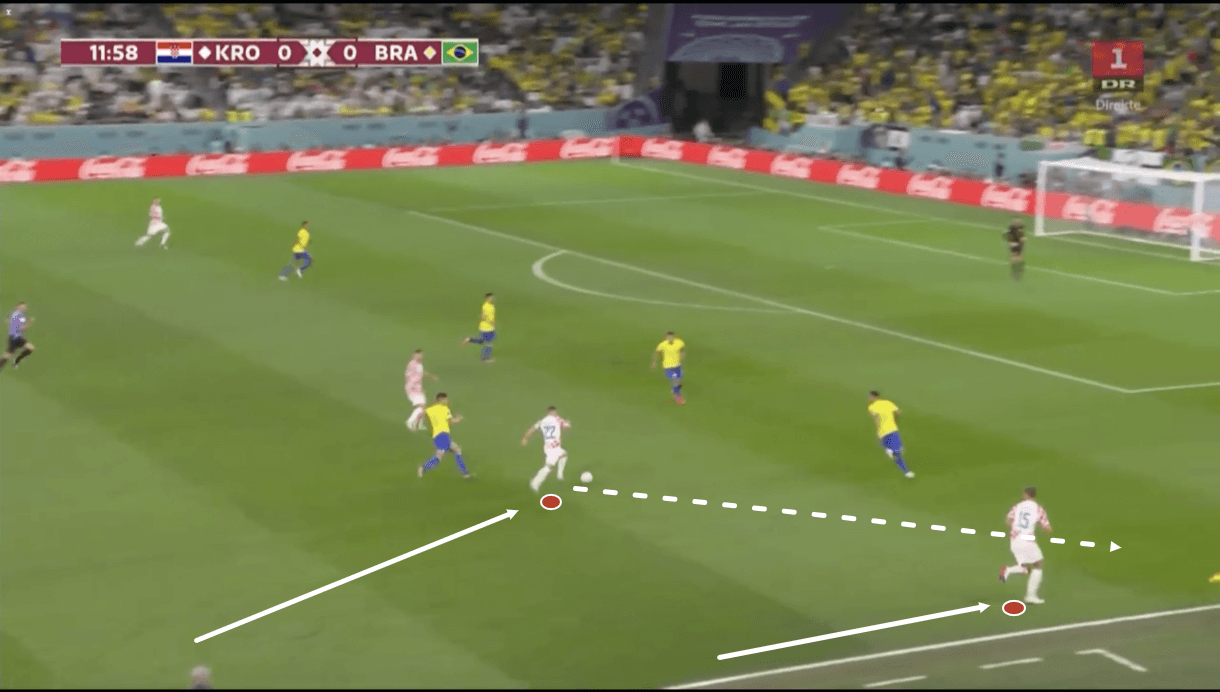
Figure 13 provides another example of Croatia’s wing play which was pretty effective against Brazil. Here, the right-back, Juranović, has carried the ball forward and as he starts moving inside, he attracts Danilo towards him slightly. This creates space for Pašalić to attack behind the left-back, who’s now in a 1v2 scenario against the Croatian attackers.
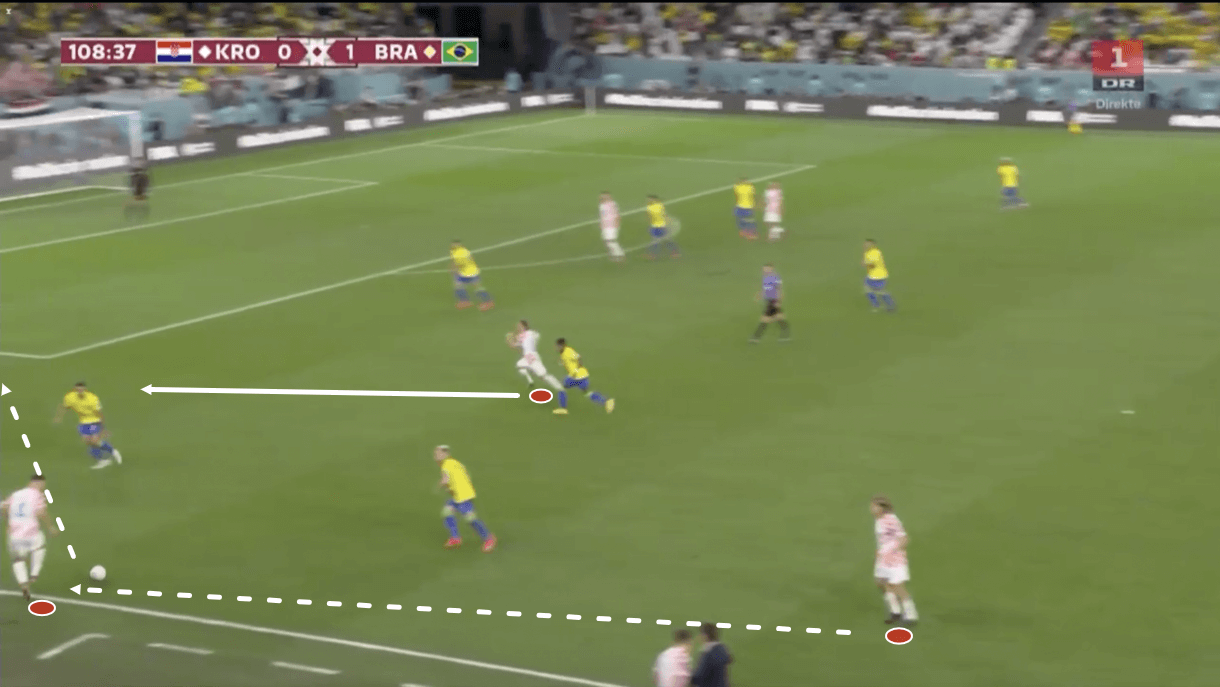
In figure 14, the Croatian runner is, again, targeting space behind the full-back who’s been drawn to the man on the ball. Again, Croatia were able to get in behind the defender like this here.
So, we can see how Croatia’s wide overloads were so effective at generating chances behind the Brazil full-backs from these examples.
Conclusion
To conclude our tactical analysis, both teams demonstrated some interesting ideas in possession but were ultimately thwarted by some solid defensive approaches on both sides. A draw was probably a fair result over 120 minutes as neither side showed enough to deservedly claim they should have won, more of the impetus was on Brazil to force the issue, however, as the stronger team, they paid the price for not managing to create enough with their penalty shootout exit.





Comments